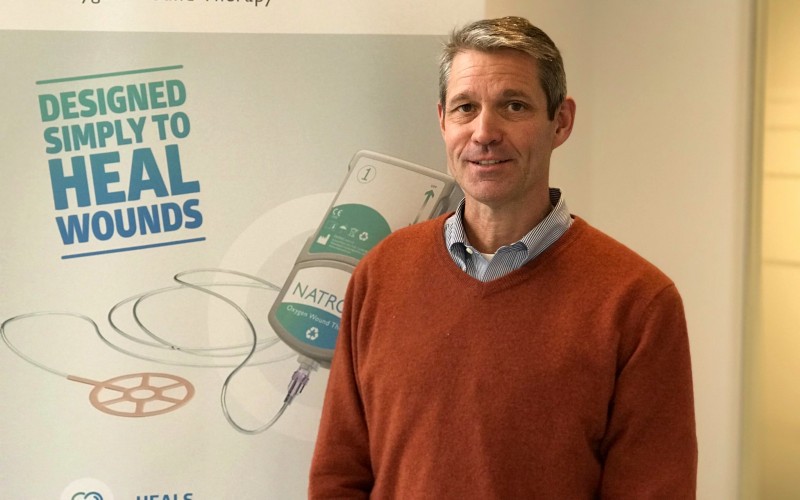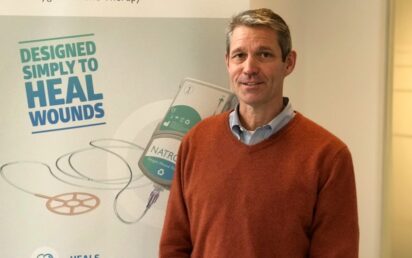Having run my first marathon in London recently, I can testify to the importance of discipline, focus and planning in reaching the finish line.
That experience pales in comparison to that of Inotec CEO Craig Kennedy, a keen marathon and ultramarathon runner. “I try to do an Ironman triathlon or two a year, if time permits,” he tells TechBlast. “It’s how I escape and stay sane.”
US-based Kennedy took over as CEO of Cambridge University spinout Inotec – No.1 on our sister publication BusinessCloud’s MedTech 50 ranking last year – in 2018. Its NATROX® O₂ device, smaller than an iPhone, uses pure oxygen to cure the wounds of patients.
The device has undergone more than two decades of development and features a ‘wheel’ design – made from a supple, pliable material – which molds effortlessly to wounds to deliver pure oxygen and stimulate healing. Non-invasive and portable, it is suitable for home use as well as in clinical settings.
“Medical device takes a long-term commitment,” explains Kennedy. “You also have to be very, very smart on how you proceed.
“You can’t make short-term decisions in a long-term business. I see it all the time where people make short-term decisions that will hurt them long-term. Stuffing the distribution channel does nobody any good… ultimately, this is a marathon, it’s not a sprint, and you have to do everything right along the way – just put one foot in front of the other.”
Channel stuffing is a deceptive business practice where a company inflates its sales and earnings figures by deliberately sending retailers along its distribution channel more products than they are able to sell to the public.
Systagenix
Kennedy entered the wound care sector as VP of business development at Johnson & Johnson business Systagenix in 2008. “I accepted the job with Johnson & Johnson – then within three weeks I found out we had been sold to a private equity company!” he reveals.
“It was a little scary, because I didn’t know anything about the market and didn’t know anything about that industry. It was fascinating, quite frankly, to learn from people, not only in the industry, but also how that world works: you fix it, you make it profitable, sell it and move on.
“It kind of got addictive after that.”
He was also fascinated by the wound care industry. “I thought that you got a cut; put a bandaid (plaster) on it; it heals; and you move on. I didn’t think it was a big deal.
“I knew very little about what these patients go through, the limited options they have. It was really eye-opening.”
Inotec – NATROX® O₂ device heals wounds with humidified oxygen
The Titanic & World War One
Systagenix’s facility in Gargrave outside Skipton, North Yorkshire, was the first overseas plant that Johnson & Johnson had ever bought. “It made the blankets that went on the Titanic,” Kennedy offers. “Johnson & Johnson bought it and used it to make gauze during World War One. It spun into a wound care business from there.
“When they spun out Systagenix, that plant was still operating.”
Much later, during Kennedy’s time at the company, Systagenix divested the pharmaceutical product and several deals followed. “I got to understand the market, the players, the process, and how long it takes to launch new products in this market.
“It takes forever! MedTech in general, but wound care as well.”
Following the sale of Systagenix, Kennedy became the first CEO of MolecuLight – a startup which visualised bacteria and measured wounds at the point of care. “We got it from a cool idea, a little bit of money, into something that was a product that we could manufacture and sell, got it registered,” he says.
“After leaving that, I was honestly looking at ways to get out of the wound care space and into something else. But when I got the opportunity with NATROX and InoTec, it was one of the few companies that I would stick around for – because I truly believe in the technology.
“After being in the market for so long you kind of get to know what works and what doesn’t – and this one just ticked all the boxes.”
Patient focus
He adds: “I wholeheartedly believe that if you can get something that can heal that patient, and make a difference in that patient’s life, you will be successful.
“There are a lot of other things you have to do – I’m not naive – but if you start with the patient, ultimately, that ticks all the boxes. It gives you purpose; a value proposition focused on them; and if they like it, they’re going to tell other patients, family members – and it grows from there.
“If patients are happy, doctors are happy, clinicians are happy, and you sell a lot and get reimbursement, your shareholders will be happy. At the end of the day, we can’t make our shareholders happy without focusing on our patients.
“If the patient doesn’t have a good experience, we don’t have a good business.”
NATROX® O₂ is now available via the UK’s NHS Supply Chain and NHS Shared Business Services, while it is gaining traction in the United States and Asia.
Kennedy, who is also rebuilding a 1969 Corvette in his spare time, concludes: “It’s such a simple product. I think the one thing I’ve learned after being in medical devices over the years is that efficacy is good; but simplicity is more important. If people don’t use it, it’s not going to work.”


